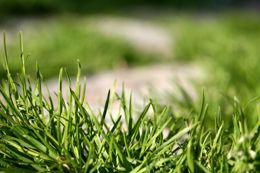Some basic grass growing tips include soil preparation, buying the correct grass type, sowing the right grass seeds, appropriate irrigation, fertilization, controlling weed growth, mowing, and aeration. Read this article to know more.

Grass plays a major role in beautifying the garden's landscape design. In fact, a landscape looks complete only when supplemented with grass lawns and grass fillers. They are also ideal for creating a color pattern in a flower bed. As per the flower garden layout, grasses are planted either on the borders of the beds or as background. You can create an eye-catching view with a touch of grass and greenery along the sides of the vibrant-colored flower beds.
It is to be borne in mind that grasses, similar to any other plants, have specific requirements that are necessary for their optimal growth. Let's discuss in brief about the effective grass growing tips, which can be practiced for creating a lustrous green lawn or garden fillers.
The method may vary depending upon the type of grass that you are interested in planting. The thumb rule is planting the right variety at the right time and in the right place. Understanding this and other basic rules will help you create a healthy lawn that looks green throughout the year.
Soil Preparation: Autumn is an ideal season for growing a majority of grass varieties. Prepare the soil in this month as you would do for any other plantations. Shallow tilling of the soil will also work as grasses have a shallow root system. Based on the type of grass that you have chosen, the nutrient requirements may differ. For poor soil that is deprived of essential plant nutrients, you can supplement it with farmyard compost and/or organic fertilizer.
Grass Variety: For growing grass successfully, make sure you select the correct variety that will be able to adapt to the soil and environment conditions of your area. If the location is shady that receives only 2-6 hours sunlight per day, you can opt for the American shade variety. Native grass varieties grow best in any area. Consult with your local horticulturist for choosing the correct grass type for your lawn or garden.
Sowing Grass Seeds: Seeds can be sown on bare soil or an existing lawn. If possible, always sow grass seeds in bare soil. Doing so will lead to optimum germination of the grass seeds. Otherwise, presence of any sort of competing plants hampers the germination and/or growing of grasses. Once the seeds have been sowed, cover them with a layer of soil to quicken the germination process.
Irrigation and Fertilization: Irrigate and soak the soil deeply. In the first few weeks, you can irrigate the area on alternate days. Reduce watering frequency after the grasses have germinated. Addition of proper fertilizers at the right time is necessary for healthy growing of grass. In case of grasses that are growing in a shady location, limit the use of fertilizers.
Weed Control: Weed control is another important factor that aids in growing grass. Presence of weeds leads to lesser availability of water and nutrients, thus resulting in poor growth of the grass. In order to avoid this condition, ensure that you remove the weeds regularly. You can make use of mild herbicide for controlling the weeds with less effort.
Grass Mowing and Aeration: Mowing the grass to a suitable height level is important for maintenance of lawns. Cutting the grass to a very short level will lead to disease infestation. Thus, mowing should be done carefully to avoid such risks. Circulation of air is a must for healthy and lustrous green lawns. You can take a lawn aerator on rent for aerating the soil.
One should also have a keen eye and watch out for signs of presence of diseases and pests in the grass or around the growing site in order to preserve the beauty of the lawn.






 Grass plays a major role in beautifying the garden's landscape design. In fact, a landscape looks complete only when supplemented with grass lawns and grass fillers. They are also ideal for creating a color pattern in a flower bed. As per the flower garden layout, grasses are planted either on the borders of the beds or as background. You can create an eye-catching view with a touch of grass and greenery along the sides of the vibrant-colored flower beds.
Grass plays a major role in beautifying the garden's landscape design. In fact, a landscape looks complete only when supplemented with grass lawns and grass fillers. They are also ideal for creating a color pattern in a flower bed. As per the flower garden layout, grasses are planted either on the borders of the beds or as background. You can create an eye-catching view with a touch of grass and greenery along the sides of the vibrant-colored flower beds.